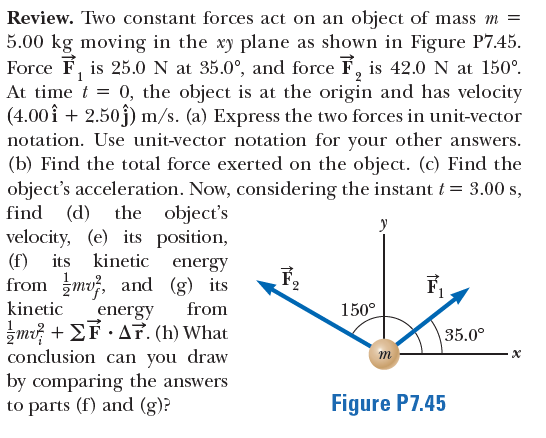Review. Two constant forces act on an object of mass m = 5.00 kg moving in the xy plane as shown in Figure P7.45. Force F, is 25.0 N at 35.0°, and force F, is 42.0 N at 150°. At time t = 0, the object is at the origin and has velocity (4.00î + 2.50j) m/s. (a) Express the two forces in unit-vector notation. Use unit-vector notation for your other answers. (b) Find the total force exerted on the object. (c) Find the object's acceleration. Now, considering the instant t = 3.00 s, find (d) velocity, (e) its position, (f) its from mv, and (g) its the object's kinetic energy F kinetic from 150° energy Jm Σ . Δr. (h) What conclusion can you draw by comparing the answers to parts (f) and (g)? 35.0° m Figure P7.45
Review. Two constant forces act on an object of mass m = 5.00 kg moving in the xy plane as shown in Figure P7.45. Force F, is 25.0 N at 35.0°, and force F, is 42.0 N at 150°. At time t = 0, the object is at the origin and has velocity (4.00î + 2.50j) m/s. (a) Express the two forces in unit-vector notation. Use unit-vector notation for your other answers. (b) Find the total force exerted on the object. (c) Find the object's acceleration. Now, considering the instant t = 3.00 s, find (d) velocity, (e) its position, (f) its from mv, and (g) its the object's kinetic energy F kinetic from 150° energy Jm Σ . Δr. (h) What conclusion can you draw by comparing the answers to parts (f) and (g)? 35.0° m Figure P7.45
Physics for Scientists and Engineers, Technology Update (No access codes included)
9th Edition
ISBN:9781305116399
Author:Raymond A. Serway, John W. Jewett
Publisher:Raymond A. Serway, John W. Jewett
Chapter8: Conservation Of Energy
Section: Chapter Questions
Problem 8.62AP: A 1.00-kg object slides to the right on a surface having a coefficient of kinetic friction 0.250...
Related questions
Question

Transcribed Image Text:Review. Two constant forces act on an object of mass m =
5.00 kg moving in the xy plane as shown in Figure P7.45.
Force F, is 25.0 N at 35.0°, and force F, is 42.0 N at 150°.
At time t =
0, the object is at the origin and has velocity
(4.00î + 2.50j) m/s. (a) Express the two forces in unit-vector
notation. Use unit-vector notation for your other answers.
(b) Find the total force exerted on the object. (c) Find the
object's acceleration. Now, considering the instant t = 3.00 s,
find (d)
velocity, (e) its position,
(f) its
from mv, and (g) its
the object's
kinetic energy
F
kinetic
from
150°
energy
Jm Σ . Δr. (h) What
conclusion can you draw
by comparing the answers
to parts (f) and (g)?
35.0°
m
Figure P7.45
Expert Solution
This question has been solved!
Explore an expertly crafted, step-by-step solution for a thorough understanding of key concepts.
This is a popular solution!
Trending now
This is a popular solution!
Step by step
Solved in 4 steps with 3 images

Recommended textbooks for you

Physics for Scientists and Engineers, Technology …
Physics
ISBN:
9781305116399
Author:
Raymond A. Serway, John W. Jewett
Publisher:
Cengage Learning

College Physics
Physics
ISBN:
9781285737027
Author:
Raymond A. Serway, Chris Vuille
Publisher:
Cengage Learning

Physics for Scientists and Engineers, Technology …
Physics
ISBN:
9781305116399
Author:
Raymond A. Serway, John W. Jewett
Publisher:
Cengage Learning

College Physics
Physics
ISBN:
9781285737027
Author:
Raymond A. Serway, Chris Vuille
Publisher:
Cengage Learning